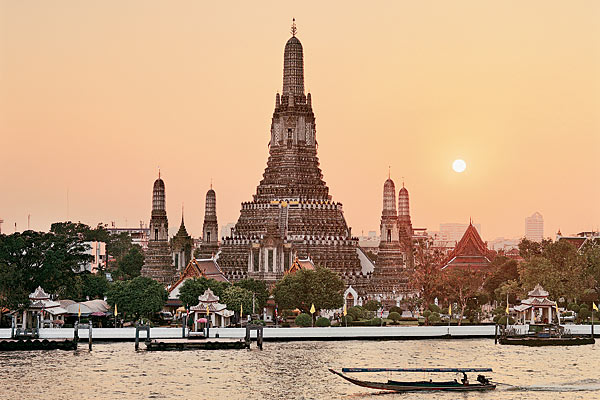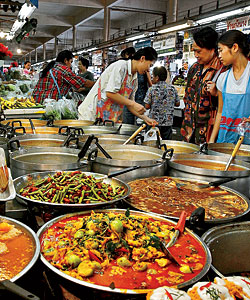As told to Nina Kokotas Hahn

A temple on the Chao Phraya River
OUR GUIDE, MARK PALICKI: Vice president of marketing, Fortune Fish Company
Palicki, who directs marketing for the Midwest’s largest seafood distributor and is also a chef, travels twice yearly to Asia. Bangkok (population: 9.3 million) is the Glen Ellyn resident’s favorite city in the region, for its food and vibrant culture.
GO NOW: Thailand’s cool season—November through February—delivers balmy weather, particularly compared with Chicago’s winter. Expect highs in the upper 80s, prevalent sunshine, minimal rain, and low humidity.
Bangkok is known for its waterfront, where traditional long boats ferry riders on the Chao Phraya River, but I like to take long walks whenever I travel to a new place. In Bangkok, walking is an enthralling form of culture-watching—not to mention one of the best ways to avoid the city’s infamous gridlock.
Throughout the city, you pass intriguing restaurants, markets packed with exotic produce, high-end malls of epic proportions, and street vendors hawking every imaginable product—from cola served in plastic bags to custom-made suits. All around you, people flock to elaborate temples to pray. They also stop at statues of Buddha, found in almost every restaurant and store, to leave humble alms, such as pieces of fruit.
Food, especially street food, is a big part of life in Bangkok, and you quickly see why—it’s entirely local, fresh, and cheap. The smells of lime juice, cilantro, fish sauce, and curries dominate the air. Food carts are an important part of everyday life, and you find them everywhere, with locals lining up for lunch or take-home dinners. And markets can be delightfully overwhelming, with row upon row of fresh seafood and Thai produce, much of which is hard to come by in the United States.
In fact, my favorite fruit in the world is Thailand’s mangosteen, which is harvested from a tropical evergreen. It’s presented whole, with its bright green stem and purple shell intact to keep the interior fresh until the very last moment. When you finally pry it open, you score this gorgeous creamy white fruit inside that is unlike anything I’ve ever had before: fleshy, fatty, sweet, and tangy. The experience of eating it is nearly indescribable.
MARK PALICKI’S BANGKOK ADDRESS BOOK
STAY
One of Thailand’s oldest hotels—and easily among its most luxurious—the 136-year-old Mandarin Oriental, Bangkok (48 Oriental Ave., Soi 40 Charoen Krung Rd., 66-2-659-9000, mandarinoriental.com/bangkok; doubles from $525) sits in the bustling Bangrak district, right on the banks of the Chao Phraya River. I’m a sucker for its incredibly friendly service, four-story spa, and daily room service of fresh Thai fruit. Equally luxurious but in a more placid location, the Peninsula Bangkok (333 Charoennakorn Rd., Klongsan, 66-2-861-2888, peninsula.com/bangkok; doubles from $454) sits in the Thonburi neighborhood on the residential side of the river. (But sleek lighted teak boats are waiting to carry you the five-minute ride to central Bangkok’s chaos.) New this year, the Siam (3/2 Thanon Khao, Vachirapayaabal, Dusit, 66-0-2206-6999, thesiamhotel.com; doubles from $530) is a boutiquey alternative to more traditional options, with 39 butler-serviced suites, high white ceilings, and a downtown yet serene vibe.

A Bangkok market
EAT AND DRINK
Food carts are abundant throughout Bangkok and are among the best ways to devour the city’s thoroughly exotic and colorful menus. I always stop for green papaya salad or freshly cut pineapple tossed with Thai chilies and sugar, Thai breakfast crêpes, and khanom krok—crispy cakes sweetened with a creamy, gooey coconut milk concoction. For a casual seated outdoor lunch, try Café Ice des Arts (70/72 Soi Charoen Krung Rd. 47/3, Bangrak, 66-2-636-7373). The restaurant also is serviced by the Golden Duck Noodle food cart, which brews a flavorful duck broth soup with tender duck meat, rice noodles, and traditional Thai seasonings. Mingle with local families during an authentic dinner at Taling Pling (60 Pan Rd., Silom, 66-2-234-4872). It’s not fancy or service driven, but you won’t care when they present you with outstanding dishes such as fried mackerel with vegetables—the national dish of Thailand. For an elegant Thai dining experience, try Nahm, inside the hotel Metropolitan by Como (27 S. Sathorn Rd., Tungmahamek, Sathorn, 66-2-625-3333, comohotels.com/metropolitanbangkok/dining/nahm). Its Aussie chef, David Thompson, turns out intensely prepared classic cuisine, including Thai canapés and fermented sour fish with prawns.
DO
Take the BTS SkyTrain (66-2-617-7300, bts.co.th; fares from 50 cents), Bangkok’s elevated rapid-transit system. Aside from providing citywide travel with scenic views, it’s also one of the best ways to avoid the city’s notorious traffic jams. Ride BTS to the National Stadium stop to visit the Jim Thompson House (6 Soi Kasemsan 2, Rama 1 Rd., 66-2-216-7368, jimthompsonhouse.com; $3.25 admission). The remarkable complex was built in 1959 from six previously distinct traditional teak houses for Thompson, the legendary American “Thai Silk King.” Travel about 15 minutes by cab to spend half a day marveling at the enormous Grand Palace (Th Na Phra Lan Rd., next to the Temple of the Emerald Buddha, bangkokforvisitors.com/ratanakosin/grand-palace; admission from $8), a 60-acre royal complex that was built in 1782 for the kings of Siam.
SHOP
You’ll forgive the absolute mess spilling out of Thai Home Industries (35 Oriental Ave., Soi 40 Charoen Krung Rd., 66-2-234-1736) once you spy the teeny shop’s curious crafts and inexpensive handmade kitchen wares. Or get lost in the 35-acre Chatuchak Weekend Market (Chatuchak Park MRT station, chatuchak.org), a gargantuan bazaar that is as much a wild flea market as it is an upscale emporium. The crazy maze of 8,000-plus stalls offers everything from homespun clothing to exotic pets. Just south of Chatuchak, the Or Tor Kor Market (Kampangphet Rd., near the Kamphaeng Phet MRT station)—among the world’s largest fresh-food markets—has a staggering array of Thai seafood, curries, and produce, including mangosteens.
Photography: (top) Martin Puddy/The Image Bank via Getty Images; (right) David Lefranc/Gamma-Rapho via Getty Images


